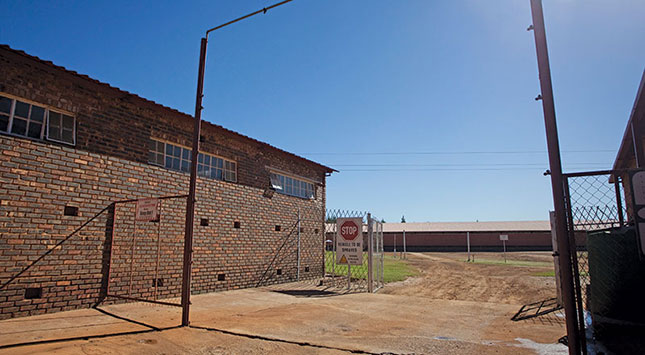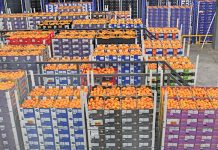
Photo: Gerhard Uys
One has to use common business sense when starting out in farming, says Erik Naudé of De Hoop farm near Amsterdam in Mpumalanga. Naudé began farming Beefmaster cattle in 1987 and added 20 000 layer hens to his operation in 1996. He also has wattle, pine and eucalyptus plantations.
“You first have to determine if there is a market and then see if you have space for the facility,” he explains. “Thereafter, you need to have an environmental impact assessment done that must be approved by the authorities.
“Infrastructure has to be planned well. You have to assess the terrain and make sure cages are set up correctly. Open cages have to be set at a specific angle to the sun, otherwise chickens will burn to death. “In our case, we also have sorting and packing facilities that have to be close to cages to help with ease of handling,” he says.
Naudé stresses the importance of purchasing the best equipment possible, and in appropriate quantities to ensure a safe, healthy environment for the birds. He employs 22 workers for the poultry operation and a further 85 on the rest of the farm.
A passion for perfection
Naudé has obvious pride in his operation, his staff and the high standards of the enterprise. He pays particular tribute to staff members, Mari van Wyk, Hardus and Mariette van der Linden and Corna Cronje. “You must have a passion for this,” he stresses. “You must greet the hens in the morning and say goodnight in the evening. You must observe intensely and know what is happening 99% of the day. Anything can have an effect on the hens, even temperature variations and you have to constantly observe.

“You have to use all your senses – what you see and hear and smell tells you a lot. Hens let you know if they are unhappy. Look at everything. Observe what the egg looks like. Underlying problems have consequences.” Naudé emphasises that there is no place for procrastination in intensive farming. “The tasks for a particular day have to be completed on that day and not left for later,” he says.
Comprehensive software
Naudé uses Amberlink hens in his operation, buying them from Mkhombe Properties Holdings. The brain and heart of the De Hoop operation is Dekalb Amberlink software; it is used to record data including body mass, egg mass, mortalities and production, on a daily basis. This information is used by the consulting vet to compile statistics that is circulated to members of a consulting group.
The group has 7 million layers across South Africa. This means Naudé can compare what happens on De Hoop with other farms, thereby promoting efficiency and accuracy. “Our egg mass is better than the norm,” says Naudé. “We get better results because we manage well. The love we put into it also helps.”
A 90% production rate is achieved with 22-week-old hens, while the norm is 86%. At 18 to 80 weeks, De Hoop’s hens achieve an 89% production rate. The 60 000 hens on the farm lay a total of about 54 000 eggs daily (4 500 dozen). Eggs are delivered daily to local clients and retail supermarkets in a 150km radius. Naudé says that the increased cost of delivering any further away is prohibitive.
Quality, lay-ready pullets
It is important to have a good supplier of lay-ready pullets that uses a vet to ensure that a correct vaccination programme is followed, says Naudé. Pullets should be bought at 18 to 20 weeks and the correct body weight so they are able to start producing at about 19 to 20 weeks.
Naudé uses Amberlink hens because of their well-researched genetics. These have been improved to such an extent that production can remain profitable up to 85 weeks, with an average 80% production rate. Naudé’s hens produce from week 19 to 20 until week 83; in his experience, Amberlink hens are the only layers with a laying lifespan of this length.
Notwithstanding these genetics, Naudé stresses that providing food and water, care, attention, and a suitable environment, are all essential for success. It is crucial to sort hens according to size when they arrive, says Naudé, as it affects production. Between 21 and 28 weeks, his workers re-sort the hens five to six times in total. In this way, he ensures that weaker hens are not dominated and produce just as well as bigger hens.
Hens are exposed to artificial lighting for 16 hours per day from 4am to 7am and 5pm to 8pm and the last feed is given at 7pm.
Vaccination programme
The vaccination programme is designed by a poultry specialist and must be stringently followed until the hens reach culling age. Laying cycles are maintained as a result of the mixed-age chicken houses, which are divided into three rows of 4 000 hens each. Replacement hens can be added in these rows, ensuring a constant production cycle.
“It is important, because it gives us the opportunity to do maintenance and disinfect without pressure before the next batch arrives.”
Naudé believes in having two feed suppliers. “I take the farm and divide it in half and assign a portion to each supplier. It’s good when suppliers compete with each other. But a lower price isn’t always good. One has to look at the feed content,” he says. Naudé feeds the hens TWK Layer 95 or Feedmaster Layer 115, depending on body weight. A total of 36t of feed is delivered to De Hoop eight times per month depending on the number of hens being fed during that month.
Expert help at hand
“Our poultry consultant, Dr Scott Elliott, plays a critical role in the business. He knows precisely when what is needed,” Naudé explains. “Someone who starts out and cannot afford a poultry consultant must try to read up as much as possible and source all the relevant information.”
Records
Because eggs have an expiry date, they are collected daily. Records are kept of every batch produced every day, as well as feed consumption and water intake. Naudé maintains egg mass output (EMO) at a lower rate than the breed average and says a younger hen’s feed consumption differs from that of a 70-week-old hen.
EMO measures the kilogram egg mass output per day for the flock. This means a flock at 600kg/ day for 10 000 hens, or if expressed as g/ bird/ day, birds laying at 94% with a 64g egg weight are producing EMO of 60g/bird/day daily. The industry’s food conversion ratio (FCR) standard is between 1,6 and 1,68, with the group average at 1,52 to 1,58. De Hoop operation currently maintains a 1,56 rate. FCR represents the amount of food (in grams) that is needed to produce a fixed amount of eggs. FCR determines the intake and production per row and is higher in younger hens, but stabilises with age.
Disease control measures
A mist-spray system is used to vaccinate for Newcastle disease and infectious bronchitis (IB). Random blood samples are taken and analysed for these diseases at 22 to 28 weeks. Chickens are not culled outright if disease is present but are re-tested after 48 hours. If there are further indications of disease, the hen is isolated.
Detailed records of all incidences of disease are kept. A vet trains and retrains workers on how to handle the birds correctly, clean them properly, kill and remove diseased hens, and collect eggs.
Waste removal
De Hoop has a daily cleaning programme to maintain hygiene levels. Manure is removed once a week using a conveyor belt system that ferries it directly onto a truck for composting. The feed system is cleaned twice a week. Naudé says he prefers to flush the system with clean water and not use chemicals, although HP Active, which eliminates algae, is sometimes used overnight. As hens do not like the taste of the chemical, water treated with HP Active has to be replaced. De Hoop has a ‘clean as you go’ policy.
“If you clean daily, you know you have a handle on cleaning and there is less chance of contamination,” says Naudé.
The farm’s water is tested every month for auditing purposes. Producers are audited according to a set standard and if all documentation is up-to-date and in place, the audit will run smoothly.
“Documentation and controls are of cardinal importance,” Naudé stresses.
Hens that have died of natural causes or been destroyed are stored in a freezer before being sent to a predator sanctuary as feed. Culling is carried out according to SPCA specifications. Cracked eggs are processed with other waste material and used for composting. Compost is used as fertiliser in the plantations and used to grow cattle feed. The remainder is sold.
Biosecurity
The farm is fully HACCP- and FSA-compliant. To adhere to the strict biosecurity requirements, all De Hoop’s products are delivered to clients, thereby ensuring that no unauthorised persons enter the farm. Before entering the farm visitors must sanitise their hands and immerse their shoes in a foot dip. Vehicles have to pass through a spray booth.

Visiting personnel from other poultry farms are required to shower on arrival and again before leaving, while workers also change into work clothes when they arrive for duty, with work clothes being washed daily. Rats are controlled with Rentokil bait boxes placed all over the farm.
Spacious and comfortable
De Hoop uses primarily Big Dutchman hen houses. Although these are made to accommodate seven hens, Naudé allocates six per house. This gives them more space and has a positive influence on production, he says. The hen houses on the farm are open and tarpaulin coverings are used for temperature control in winter. Nearly 75% of the operation is automated and Naudé says his dream is for the operation to eventually become completely automated.
Phone Erik Naudé on 082 559 7870.
This article was originally published in the 3 July 2015 issue of Farmer’s Weekly.













